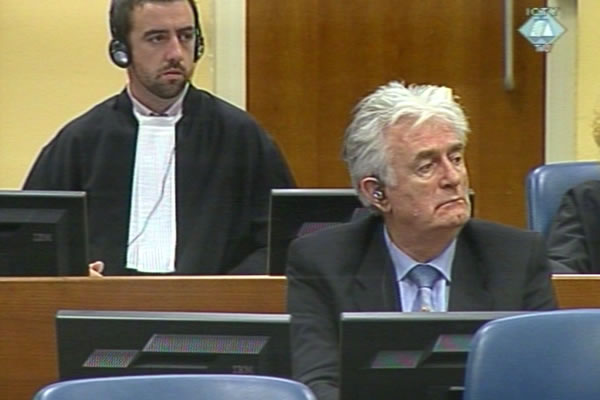Home
SURVIVOR FROM PETKOVCI DAM GIVES EVIDENCE
The trial of Radovan Karadzic continued after the Tribunal’s winter recess with the evidence of a witness who survived the execution of about 1,000 Muslim men and boys at the Petkovci dam in the night of 14 July 1995. After the witness finished his evidence, the prosecution called British pathologist John Clark. From 1999 to 2001, Clark was in charge of the post mortems of the victims exhumed from Srebrenica mass graves
 Radovan Karadzic in the courtroom
Radovan Karadzic in the courtroom The trial of former Republika Srpska president Radovan Karadzic continued today with the evidence of Witness KDZ 045. The witness described the execution of the captured men and boys at the Petkovci dam. As alleged in the indictment, the Serb forces executed about 1,000 Muslim captives at that site in the night of 14 July 1995. The witness’s testimony at the trial of Radoslav Krstic was admitted into evidence today, as were the photos of the school in Petkovci and the crime scene at the dam.
According to the summary of the witness’s previous evidence, after the fall of Srebrenica on 11 July 1995 the column of about 13,000 to 15,000 men and 300 women headed towards the territory under the BH Army control through the woods. The witness was in the rear of the column. He could hear the Serb soldiers calling the Muslims to surrender over a loudhailer. The Serb soldiers assured the Muslims they would be treated in line with the Geneva conventions. The witness and 30 other people decided to surrender.
However, instead of being exchanged as they had been promised, the prisoners were first taken to Konjevic Polje and then to a football stadium in Nova Kasaba. Ratko Mladic visited them there. After Mladic left, the witness and about 100 prisoners were ordered to get on a truck where they were held the whole night and the next morning. During the night, the witness heard screams, groans, calls for help and bursts of gunfire. Five prisoners were taken from the truck, never to return.
The next day, the witness and other prisoners were taken to the school in Petkovci in trucks. The prisoners were ordered to run a gauntlet of soldiers to the school with their hands on back of their heads. The soldiers hit the prisoners with rifle butts and forced them to shout ‘long live Republika Srpska’ and ‘Srebrenica is Serbian’. The witness was ordered to strip to the waist and go back to the truck. The witness and the other prisoners were then taken by truck to an illuminated field near the dam. It was already covered with dead bodies. The prisoners were taken out in groups of five and were then shot in the back.
When fire was opened on his group, the witness fell facedown over the bodies of the prisoners who had already been killed and tried to tuck his head beneath their legs. The witness remained there for some time playing dead and listening to the soldiers fire single shots to the heads of those who were wounded. When the soldiers left, the witness and another survivor hid in a nearby concrete culvert. The next day, they headed towards Tuzla and two days later crossed into the territory under the BH Army control.
In the cross-examination, Karadzic put it to the witness that from mid-April to mid-July 1992 the witness was in the Territorial Defense, that his unit attacked the Serb villages and that the subsequent executions were carried out as revenge. In a bid to ‘establish the unfortunate results of the civil war’, as he put it, Karadzic brought up a BH Army document which states that about 10,000 fighters crossed into the liberated territory from Srebrenica. According to the document, a large number of Muslim soldiers committed suicide when they saw that they would fall into the hands of Serb forces. The witness confirmed that he saw a couple of such cases when he surrendered but dismissed the possibility that there were many such cases.
The survivor from the Petkovci dam was followed in the witness stand by British pathologist John Clark. From 1999 to 2001, Clark headed the team of experts conducting post mortems on the remains of the victims exhumed from the Srebrenica mass graves. In the reports on the exhumations in Kozluk, Konjevic Polje, Nova Kasaba and Glogova, the witness concludes that nothing in the findings indicates that the victims were killed in combat. In the cross-examination, set to continue tomorrow, Karadzic tried to prove the opposite.
Linked Reports
- Case : Karadzic
- 2011-12-09 DESTROYING CULTURAL HERITAGE
- 2011-12-08 FIGHTERS WITH BLINDFOLDS AND THEIR HANDS TIED
- 2011-12-02 ANTHROPOLOGICAL EVIDENCE FROM MASS GRAVES
- 2012-01-11 KARADZIC DENIES MASS EXECUTIONS
- 2012-01-12 WITNESS: SERB OFFICERS TOLD US THEY WANTED SREBRENICA FOR THEMSELVES
- 2012-01-13 KARADZIC 'WATCHED PANDUREVIC'S BACK'
